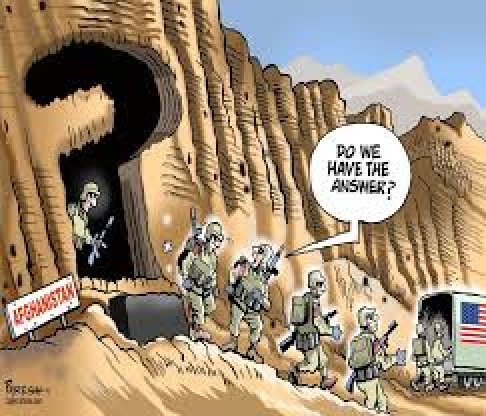
The wars that are never won, the invasions that don’t amount to a hill of beans, the democratically elected leaders that are replaced by dictators and oligarchs. U.S. fingerprints are over all of them. The march to a U.S. dominated global order after 1945 began as strategies to create a unipolar world with the U.S. exerting hegemony over all other nations. By the 2000s, the U.S. had amassed 750-800 military encampments in at least 80 countries funded by an annual trillion- dollar defense budget that exceeds those of the next ten countries combined. These bases and the trillions poured into the Pentagon vaulted the U.S. into the world’s leading militarily power.
But as countries rebuilt (ironically with funding from America’s Marshall Plan) and began flexing their economic muscle, the U.S. raised the ante demanding our “allies” and partners defend U.S. interests “Every nation, in every region, now has a decision to make. Either you are with us, or you are with the terrorists.” [President George W. Bush, 9 days after 9/11].
Communism [aka USSR] became a decades long obsession of American foreign policy as Russia went from U.S. ally to Communist menace. Using the imaginary specter of worldwide Communist domination, the U.S. intervened in the electoral politics of countries as diverse as Italy, Greece, El Salvador and Chile. In most cases an autocrat or dictator became the U.S-installed leader.

Communism remained the enemy du jour for the next thirty years. First in Korea, where the U.S. fought a losing war that cost the lives of three million Koreans and 38,000 Americans and shattered a country. Vietnam was the next big war in the fight against a phony enemy. Before the U.S. was forced to turn tail and run in 1975, over 3 million Vietnamese and 58,000 Americans lost their lives and three countries, Vietnam, Cambodia and Laos, lay in ruins.
The sixties turned out to be a banner decade for U.S. invasions. Vietnam wasn’t the only country that received the full-on U.S. military treatment. In 1965, President Johnson sent 42,000 American troops to invade the Dominican Republic. The excuse this time was to “protect American lives”. Three thousand Dominicans and thirty-one Americans lost their lives. According to plan, their democratically elected leader who had been deposed stayed deposed and the U.S. installed a dictator who ruled for twenty-eight years.
1989 rolled around and Pappy Bush out to prove his manhood sent troops into Panama, a little country of 2 ½ million people ruled by a drug dealer on the CIA payroll. Once again, the pretexts Bush spouted were unabashed poppycock — “The goals of the United States have been to safeguard the lives of American citizens, to defend democracy in Panama… Even that U.S. puppet, the U.N. condemned the U.S. invasion as a “flagrant violation of international law.”
By the nineties, with the implosion of the USSR in 1991 signaling the end of the first cold war, it was time for a new enemy. The U.S. didn’t have to wait long. In 1993, 1,200 pounds of explosives were detonated in the parking garage beneath the World Trade Center. The finger of blame pointed to a band of what were labeled “Islamic terrorists”. Behold: a new enemy. 1991 was also notable for Pappy Bush’s incursion into Iraq, the Gulf War. That was just a teaser. The real Iraq war, the start of the Global War on Terror, was brought on by another Bush and lasted eight years from 2003 to 2011 (although some U.S. troops remain there to this day). Hewing to the script, U.S. motives were once again labeled as noble and altruistic — “to disarm Iraq, free its people and save the world from grave danger [and to] undermine Saddam’s ability to wage war… [President George W. Bush] In essence the U.S. was invading a country that had no part in 9/1, no WMDs and posed no threat to U.S. national security. The U.S. wrecked the country anyway.
With a new enemy, Islamic extremists, came a whole new batch of reasons for invading and destroying countries. The most enduring — fight them there so we don’t have to fight them here — was first articulated by President GW Bush defending the U.S. invasion of Iraq: We will meet that threat now…so that we do not have to meet it later…on the streets of our cities…”
When it was Obama’s turn to spout the big lie to defend another war, this time in Afghanistan, he put the Obama touch on the “there not here” meme: Those who attacked America on 9/11 are plotting to do so again. If left unchecked, [there will be] an even larger safe haven from which Al Qaeda will plot to kill more Americans…

As the clock wound down on each U.S. adventure, the term victory became fungible. It was always right around the corner. In the Vietnam era, the president, his foreign policy team and the military reassured the American people that there was “light at the end of the tunnel.” Until there wasn’t. Moving to Iraq three decades later, another victory came and went. President Bush declared “mission accomplished shortly after the invasion. It wasn’t. Eight long years later, the U.S. finally threw in the towel. On to Afghanistan, another example of U.S. victory fantasies flying in the face of reality. Four Presidents — Bush ’43, Obama, Trump and Biden — reassured the people that U.S. was one surge away from winning. Here’s Biden as both vice president and president dutifully reciting the U.S. script for failed invasions: “…as I speak our soldiers are making measurable progress on the overarching goal…to defeat Al Qaeda [Vice-President Biden, 2010]. Whoops, that “overarching goal” was not to be. Time for a new metric to explain away the inevitable loss. “We decimated Al Qaeda central, we have eliminated Bin Laden, that was our purpose… We are leaving in 2014.” [Vice President Biden, 2012], By 2014, losing had become winning. “The primary objective is almost completed. Now all we’re doing is putting the Kabul government in a position to be able to maintain their own security.” [Vice president Biden, 2014]. Who knew these ‘mop-up operations would take another eight years? By 2021, Biden was President, facts on the ground had overtaken delusions of victory and it was time to depart. But as is the MO of American presidents, every loss can be made to look like a victory. We went to war [in Afghanistan] with clear goals. We achieved those objectives. As the war ground to a halt, there was some talk of reviving the Nixonian “Peace with Honor” slogan to whitewash the Afghanistan loss. Fortunately, wiser and saner heads prevailed.
Lies and fairy tales have guided most U.S. foreign policy decisions since the nineteen forties. To no avail. Overwhelming military power which has consumed so much blood and treasure has proven no match for the desire of people in targeted countries to be free of U.S. domination. It happened in Korea, in Vietnam, even the Iraqis showed the U.S. the door and Afghanistan wasn’t far behind.

Republican or Democrat, whichever side is in power, mouths the same lame excuses — ending tyranny, saving democracy, fighting the enemy du jour over there not here, restoring civil rights — to make the world a battlefield with countries ravaged and millions of people homeless. Somehow a long time ago peace fell out of favor among America’s ruling elites. It’s time to set a new agenda with the goal of international peace at the top. With only 100 minutes until the world faces “catastrophe from nuclear weapons, climate change, and disruptive technologies in other domains.” [Bulletin of the Atomic Scientists, 2022 Doomsday Clock Statement, 1/20/2022], we haven’t much time.
730 total views, 1 views today
